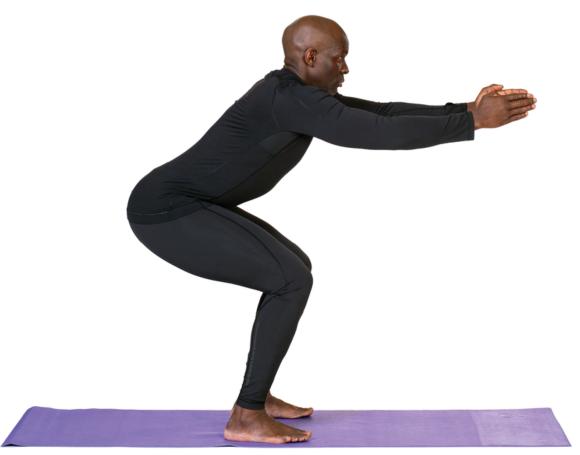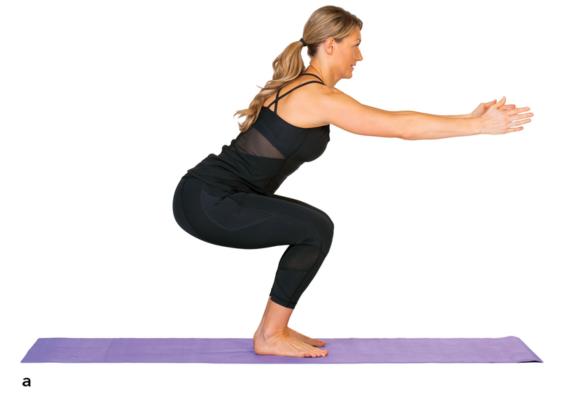Squat
This is an excerpt from Fusion Workouts by Helen Vanderburg.
Foundational Exercise
Squat


Starting Position
Start in a tall standing position. The feet are approximately shoulder-width apart and the toes point forward (see figure a). The knees align directly over the midline of the feet and extend no farther forward than the ball of the foot. The spine is in a neutral alignment and the head is in line with the spine. The eyes focus straight ahead, and the chin is tucked slightly. The shoulders are relaxed and down and away from the ears and the arms are by your side. The chest is lifted and opened by bringing the shoulder blades toward the middle of the back.
Action
Keeping the spine in a neutral and lengthened position, bend at the knees, hips, and ankles to lower the torso until the thighs are parallel or slightly higher than parallel to the floor as you descend into a squat (see figure b). Lift the pelvic floor and lower-abdominal muscles to engage the core. The torso will naturally hinge forward from the hips as you lower into the squat. Press down into the feet to push up to standing. The arms reach forward as you squat, and they lower to the side as you stand up.
Alignment
Keep the spine lengthened and torso in a tall posture as you move through the squat. The knees stay aligned over the center of the feet. Avoid letting the knees fall inward or outward as you squat.
Breath
Inhale to lower into the squat. Exhale to press up to standing, maintaining neutral alignment of the pelvis, spine, and shoulder girdle. Repeat 8 to15 times.
Technique Tips
- Keep equal weight on the balls and heels of both feet.
- Maintain the alignment of the knees with the feet to keep the knees from falling inward or outward as you lower into the squat.
- Hinge or sit back with the hips as you lower into the squat.
- Keep the chest lifted and the spine long throughout the movement.
- Relax the shoulders down and away from the ears.
- Maintain the head's neutral alignment with the spine.
Progressions and Modifications
- Hold the bottom of the squat longer for more intensity.
- Increase the range of motion by moving deeper into the squat.
- Stand higher in the squat to decrease the intensity.
Mindfulness
Control your breathing to give you strength in this challenging exercise. Take a strong breath in as you lower into the squat, and exhale to push up to standing.
Squat With Heel Raise


Starting Position
Start in a tall standing position, with the feet approximately shoulder-width apart and the toes pointing forward. Align the knees directly over the midline of the feet and extend no farther forward than the ball of the foot. The spine is in a neutral alignment and the head is in line with the spine. Focus the eyes straight ahead, and the tuck the chin slightly. The shoulders are relaxed and down and away from the ears and the arms are by your side. Lift and open the chest by bringing the shoulder blades toward the middle of the back.
Action
Lower into the squat (see figure a); at the bottom, lift both heels, balancing on the balls of the feet (see figure b). Lower the heels and stand up. Reach the arms in front of the shoulders to help you balance as you lift and lower the heels.
Alignment
Keep the knees in line with the toes as you lower into the squat and as you lift and lower the heels. The weight should stay centered across the balls of the feet. Avoid rolling the ankles in or out.
Breath
Exhale to lower into the squat, inhale to lift the heels, exhale to lower the heels, and inhale to stand up. Repeat 5 to15 times.
Progressions and Modifications
- To add intensity, stay at the bottom of the squat, and lift and lower the heels for three to five repetitions.
- To assist with balance, hold the back of a chair.
Mindfulness
Use strong breathing to help you through this challenging exercise. Focus your eyes on a single point to assist with balance.
Learn more about Fusion Workouts.
More Excerpts From Fusion WorkoutsSHOP

Get the latest insights with regular newsletters, plus periodic product information and special insider offers.
JOIN NOW


